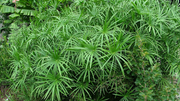
Table of Contents
The umbrella palm (Cyperus alternifolius) is an ornamental and helpful addition to your pond or water garden. Sometimes called the umbrella papyrus, this tropical plant can grow to an impressive six feet in height. For those with smaller ponds, there are also dwarf and medium varieties of the umbrella palm plant, ensuring that every pond, no matter the size, can enjoy the benefits of this beautiful and functional aquatic plant.
Versatility and Aesthetic Appeal
The umbrella palm stands out for its unique structure. Its umbrella-like leaflets sprout from tall stems, creating a striking vertical element in any water garden. Its height and stature make it a great complement to shorter aquatic plants, like water lilies, that thrive at its base. The umbrella papyrus plant adds both aesthetic appeal and dynamic motion to the pond, as the leaves gently sway in the breeze.
If you live in USDA Zone 7 or higher, the umbrella palm tree is hardy enough to remain outdoors year-round. However, in cooler climates, you can bring the plant indoors to overwinter. Simply place it near a bright, sunny window during the colder months, and once the weather warms up, return it to its place in your pond.
Controlling Growth and Invasiveness
While the Cyperus alternifolius umbrella palm is undeniably beautiful, it can become invasive if left unchecked, particularly the larger varieties. A single stalk of the umbrella sedge plant, once rooted, can spread quickly and take over the margins of your pond, especially if planted directly in gravel or soil. To avoid this, it's a good idea to plant your umbrella palm in an aquatic planter. This will restrict its roots, making the plant easier to manage and preventing it from becoming overgrown.
Pruning and Care
Caring for your umbrella papyrus plant is relatively straightforward, even when it seems like the plant is growing too large. You can prune the root ball down to a smaller size when the plant becomes too tall or full. This won’t harm the plant and can be done using a handsaw to cut the root ball into a more manageable size. You can also split the plant in half, giving you a second umbrella palm to plant elsewhere or to share with a friend.
Once you've pruned the root ball, place the plant back in its container and stabilize it with rocks that range in size from tennis balls to grapefruits. These rocks will help anchor the plant and prevent it from being blown over in strong winds, while the roots reestablish themselves in the planter.
Low-Maintenance and Beneficial for Your Pond
One of the best features of the umbrella sedge plant is that it requires very little maintenance. Unlike many other aquatic plants, you don’t need to add soil or fertilizer to the umbrella palm. It is largely self-sustaining, deriving its nutrients directly from the water. As it absorbs excess nutrients, it also helps filter the water, keeping it clean and safe for fish and other aquatic life.
Conclusion
The umbrella palm (Cyperus alternifolius) is much more than just an attractive addition to your pond; it plays an important role in maintaining the health of your water garden. Its height, ease of care, and water-purifying properties make it a versatile and practical choice for any pond. Whether you’re looking to create a focal point in your water garden or simply add a stunning backdrop for shorter plants, the umbrella papyrus is an investment that will keep on giving, season after season.







